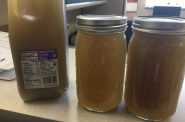Two State Prisons Have Lead-Tainted Water
Officials say they comply with federal drinking water standards, but others question whether it’s safe.

Waupun Correctional Institution has struggled with high copper and lead levels for years. The 150-year-old prison is using water treatment to keep metals from aging lead and copper plumbing from leaching into the water. Photo by Lauren Furhmann of the Wisconsin Center for Investigative Journalism.
Some inmates, staff and visitors at two Wisconsin state prisons say the water there is unsafe to use because of lead and copper contamination.
At Fox Lake Correctional Institution, 55 miles northeast of Madison, about a dozen inmates told the Wisconsin Center for Investigative Journalism that the water at the 56-year-old prison is routinely yellow or brown with dark sediment and an unpleasant flavor.
At Waupun Correctional Institution, 70 miles northwest of Milwaukee, one longtime officer said he and other staff were not aware of high lead levels in the prison’s water in 2014, although officials insist legally required notifications were made that year when the facility violated the federal lead rule.

Prisoner rights advocate Peg Swan, in her home office, with letters from inmates at Waupun Correctional Institution. She says she has been hearing for about a year about high lead levels in the water at the 150-year-old prison. Photo by Linda Falkenstein.
Prisoner advocate Peg Swan told the Center she has been hearing from Waupun inmates for about a year about high lead levels in the water at the 150-year-old prison.
Fox Lake has been working to meet terms of a 2014 consent order from the state Department of Natural Resources to lower levels of lead and copper in its water, which have been detected on and off for at least seven years.
Lead and copper contamination is caused by corrosion from aging plumbing.
Spokespeople for the state Department of Corrections said the agency has employed several strategies, including closing one well and fixing three others at Fox Lake. Fox Lake will soon begin water treatment to prevent corrosion and regular monitoring for metals, said Jeff Grothman, the DOC’s legislative affairs director.
At Waupun, water treatment also is being used. Compliance testing at Fox Lake Correctional is scheduled to begin this month.
Fox Lake also has excessive levels of naturally occurring manganese, a metal that is not considered dangerous to adults except in high doses, but it can turn water brown and give it a bad taste and smell.
Officials say both prison water systems now meet federal drinking water standards. They said the prisons have not supplied either staff or inmates with an alternative water source, although inmates are allowed to purchase bottled water and staff can bring it in.
“The Fox Lake Correctional Institution water system is following all state and federal requirements of the Safe Drinking Water Act to provide safe water for staff, inmates and visitors to use for drinking, cooking and bathing,” Grothman said.

Prisoners at Fox Lake Correctional Institution say the water there is sometimes yellow or brown, contains sediment and has a bad taste. The prison is under a consent order from the state Department of Natural Resources to rectify high levels of lead and copper in the water. Photo by Kate Golden of the Wisconsin Center for Investigative Journalism.
The Center’s ongoing Failure at the Faucet investigation into risks facing Wisconsin’s drinking water reported, however, that those standards do not always protect public health when lead or copper is present in a water system.
For example, Miguel Del Toral, a top U.S. Environmental Protection Agency official, found that concentrations of lead in water can vary widely even in samples taken from the same source on the same day. Del Toral’s study concluded that the existing federal Lead and Copper Rule, part of the Safe Drinking Water Act, “systematically misses high lead levels and potential human exposure.”
Abigail Cantor, a Madison chemical engineer who helps water utilities comply with the Lead and Copper Rule, said compliance does not mean water coming from every tap is safe. The EPA rule is designed to detect system-wide problems, not specific hotspots.
The level of lead and copper “certainly changes in each building as each building has its own plumbing configuration and water usage,” said Cantor, who is working with corrections officials to solve the lead and copper problem at Fox Lake. “Every building in a city could not be sampled, so the EPA found that there was no way to create a health-based regulation.”
Water troubles at Fox Lake
Since 2008, 18 water samples at Fox Lake have exceeded the maximum contaminant level of 1.3 milligrams per liter for copper, and six samples exceeded the maximum contaminant level of 15 parts per billion (ppb) for lead, according to the DNR database.
Although they insist the water is now safe, Fox Lake officials have told inmates, staff and visitors about the high lead and copper levels and advised them to run the water for 15 to 30 seconds before using it for drinking or cooking, or when a faucet has been unused for more than six hours. (The state DNR recommends running the water for two to three minutes under those conditions.)

Beverly Walker, whose husband, Baron, is serving time at Fox Lake Correctional Institution, told a Madison gathering organized by the faith-based advocacy group Wisdom in February that she has heard “horror stories” from inmates about the water. She said her husband buys bottled water from the prison canteen at Fox Lake. Photo by Gilman Halsted of Wisconsin Public Radio.
Several Fox Lake inmates and the spouse of an inmate said the water remains yellow or brown even after prolonged flushing. Some inmates asked not to be named for fear of retribution.
Beverly Walker, whose husband, Baron, is serving time at Fox Lake, told a Madison gathering organized by the faith-based advocacy group Wisdom in February that she has heard “horror stories” from inmates about the water.
“Recently I was informed by my husband that the water was so dirty, they couldn’t wash dishes so they were giving the inmates paper plates to eat their food off of,” said Walker, of Milwaukee.
One of the 13 inmates who wrote to the Center about water problems said he buys cases of 24 16-ounce bottles of water for $7.60 from the prison canteen — the only alternative water source. Similar cases of water can be purchased for roughly half that amount at Woodman’s Markets. The prisoner, who asked not to be named for fear of retaliation, said prisoners are limited to buying one “overpriced” case every two weeks.
Inmates who cannot afford bottled water, Walker told the group, “would fill cups up and it would be dirty, dingy and metal pieces floating in the water. Now this is after they have let the water run for about an hour … and then they would let it sit until the pieces fell to the bottom.”
DOC spokeswoman Joy Staab said she could not confirm the story about the paper plates. A DNR spokesman, George Althoff, could not identify the sediment but said whatever it is would show up in water tests.
Article Continues - Pages: 1 2
Tainted Water
-
Fecal Microbes In 60% of Sampled Wells
 Jun 12th, 2017 by Coburn Dukehart
Jun 12th, 2017 by Coburn Dukehart
-
State’s Failures On Lead Pipes
 Jan 15th, 2017 by Cara Lombardo and Dee J. Hall
Jan 15th, 2017 by Cara Lombardo and Dee J. Hall
-
Lax Rules Expose Kids To Lead-Tainted Water
 Dec 19th, 2016 by Cara Lombardo and Dee J. Hall
Dec 19th, 2016 by Cara Lombardo and Dee J. Hall





















